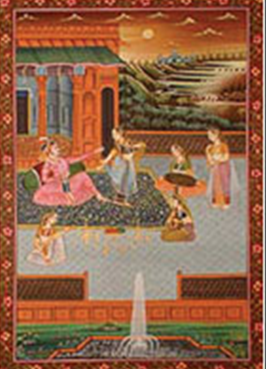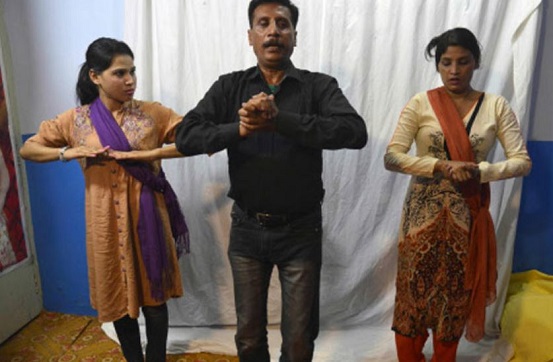Lahore: Heera Mandi
This is a collection of articles archived for the excellence of their content. |
Louise Brown’s Heera Mandi
June 25, 2006
REVIEWS: No happy endings
Reviewed by Noor Jehan Mecklai
A BEAUTIFUL young British researcher sets out to write, over a four-year period, an academic report on the history, culture, lives, aspirations, cruel disappointments, social stigmatisation and so on of the people of Heera Mandi, Lahore. She weaves her story principally around the household of Maha and her daughters, becoming so deeply involved in their daily heartbreaks that by her own admission she loses her professional moorings. This accounts partly for the colourful vigour of her style, compared with that of Fauzia Saeed in her famous Taboo. But it is unfair to compare these two books. Wait till Louise Brown gets around to publishing her actual academic report. Both books are testaments of caring, though whereas Fauzia was warned not to take up temporary residence in the area, Louise takes a room there, eventually moving in with Maha.
Whether written in a graphic, a strictly factual or an ebullient manner, Louise Brown’s revelations may elicit tears of pity and compassion, or they may raise anything from a titter to a belly laugh. Or since she really tells it like it is, one may even laugh and weep at the same thing, as, for example, when Mota, the fat, middle-aged lover, is supposed to come courting teenaged Nena, or when Maha simply cannot understand that Louise could spend an evening merely conversing with a man. But laughter flees as the pitifully young Nena is shipped off overnight to the Gulf as a concubine for a wealthy Sheikh, owing to her family’s desperate financial position. The inexorable decay of Maha’s looks and figure, exacerbated by that of her marriage, are killing the demand for her services.
However, the lively descriptions of so many things, such as the excited village family packing their shoddy finery for a successful three-month contract in Dubai, the urs of a saint, or of the train journey to Sehwan Sharif, always with an eye to the main theme, somehow prevent one’s interest from flagging, as it would have done with less relief from the filth and degradation of the lifestyle portrayed.
The salons of the best tawaifs of old, and the glamorous homes of successful mohalla women, taken by their ‘husbands’ to posh suburbs, contrast starkly with the cruelty and ignominy of Maha’s ouster from a more ‘respectable’ neighbourhood
Then there are the clever contrasts, such as that between the little girl in the church at Roshnai Gate, “so lovely and fresh, and so unlike the other girls in Heera Mandi, who are miniature women at the same age”, and Nena receiving lessons in the art of seduction from her mother. Similarly, the salons of the best tawaifs of old, and the glamorous homes of successful mohalla women, taken by their “husbands” to posh suburbs, contrast starkly with the cruelty and ignominy of Maha’s ouster from a more “respectable” neighbourhood when she tries, for the second time, to leave Heera Mandi.
Among the variety of subjects presented, Brown gives vignettes of the hijra society, describing their growing-up problems, their reasons for adopting this lifestyle, and the fate of Tasneem, who transgresses against the rules of this very insecure group by marrying. They too, like the others in the mohalla, are portrayed as multifaceyed human beings.
“I love and hate this place with equal measure,” writes Louise. “It’s both fascinating and loathsome. When I’m away, I’m desperate to return, yet when I’m here, I can’t wait to escape.” Thus, she expresses the consummate dilemma of compassionate researchers like herself in places like Heera Mandi.
The Dancing Girls of Lahore: Selling Love and Saving Dreams in Pakistan’s Ancient Pleasure District
By Louise Brown
Fourth Estate.
Available with Liberty Books, Park Towers, Clifton, Karachi
Tel: 021-5832525 (Ext: 111)
Website: www.libertybooks.com ISBN 0-06-074042-6 311pp. Rs995
Losing out to e-prostitution
AFP | Aug 23, 2016 How technology killed Pakistan's historic red light district
- Pakistan's oldest red light district, Heera Mandi was a hub of traditional erotic dancers and prostitutes.
- However, men now book rendezvous online through escort websites or even directly with women over social media.
- The historic Heera Mandi district is close to the centuries-old Badshahi Mosque in Lahore.
LAHORE: Pakistan's oldest red light district was for centuries a hub of traditional erotic dancers, musicians and prostitutes, Pigalle with a Mughal twist, deep in the heart of vibrant Lahore.
But as an e-commerce boom revolutionises how Pakistanis conduct the world's oldest profession, locals say the historic Heera Mandi district is under threat.
Balconies where beautiful women once stood are now empty, while rust eats away at the locked doors of vacant rooms. The only stubborn hold-outs are shops selling instruments that once facilitated the aperitifs of music and dance.
Men now can book a rendezvous online through escort websites or even directly with women over social media, instead of searching out streetside solicitation.
With location rendered meaningless, prostitutes like Reema Kanwal, who says the business "runs in my blood", have abandoned Heera Mandi.
The district, whose name translates as "Diamond Market", is close to the echoing, centuries-old Badshahi Mosque.
During the Mughal era, the great Islamic empire that ruled most of India and Pakistan in the 15th and 16th centuries, Heera Mandi was a centre for mujra, traditional singing and dancing performed for the elites.
The wealthy even sent their sons to the salons of tawaifs, high-class courtesans that have been likened to Japanese geishas, to study etiquette.
Later, when the British came, distinctions between courtesan or mujra dancer and prostitute were blurred.
Dance and sex became intertwined, and Heera Mandi began its long slide into sordidness, but even so, Reema remembers "glorious" days.
Reema's mother and grandmother were also prostitutes, making her part of Heera Mandi's generations of women who danced and pleased men in the market.
"People used to respect the prostitutes of Heera Mandi, we were called artists," she says, but all has changed over the last decade. "Now we don't have any honour."
She blames the loss on a rush of girls without her family background taking up the profession who have not been taught "how to treat people" the way she has.
Such girls, she says, need nothing to market themselves but a mobile phone, with which they can advertise on Facebook or Locanto, some offering services over Skype for as little as 300 rupees ($3).
Dozens of escort services with online bookings claim to serve thousands of clients in Karachi, Lahore and Islamabad, some even in Dubai and Singapore.
In a deeply conservative Muslim country where prostitution is banned and sex outside marriage is criminalised, one website says it caters to roughly 50,000 customers.
With the old traditions falling by the wayside, girls also no longer need an entourage of musicians and teachers, say the owners of the music shops that are the final remnants of old Heera Mandi.
The intricate mujra dancing that was such a foundation of the red light district required years of teaching and live musicians. Now girls learn easy but provocative dance moves via YouTube.
"They take a USB or sometimes they don't even need that, they have songs in their cellphones, they plug a cable and play the music," laments Soan Ali, one of the music shop owners.
Like Reema, Ali's family has also been in Heera Mandi for generations, and he proudly recalled his father's "hospitality" as he attempted to lure clients for his mother.
He takes a deep breath. "We are having a lot of difficulties," he admits. "Whoever is in this field is going through hard days."
For those who have migrated beyond Heera Mandi, however, the future is bright.
Mehak, who declined to give her full name, is a cosmetic surgeon by profession, a feminist by ideology, and by night one of Pakistan's most elite madams.
Seven sleek Persian cats prowl among the expensive wooden furniture of her home, which doubles as a brothel for upper-class Pakistanis in a wealthy residential neighbourhood of Lahore.
Mehak, who is in her mid-50s, says she recruits most of her girls through elite parties, but adds "this online thing has really changed the business".
"A girl no longer needs a pimp to market her, she has Facebook, Twitter," she says.
"Heera Mandi is no more... even if a girl is from Heera Mandi she would never reveal it because the client would never risk sexually transmitted diseases and the bad image associated," she added.
Outside of the Diamond Market, she says, business is good.
"Medical students and MBAs have the highest rates, they get a hundred thousand (rupees, or $1,000) for one night," she says.
Now she plans to expand and offer male prostitutes.
"Girls from the elite class come to me and beg for boys," she says.
"They say they are ready to pay, but they need strong boys."


